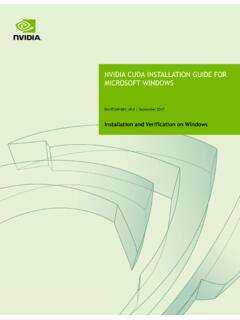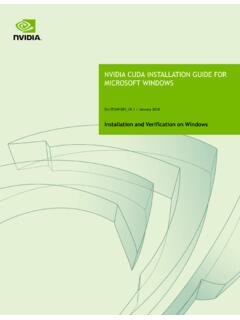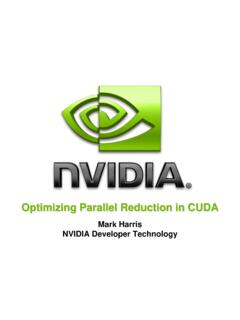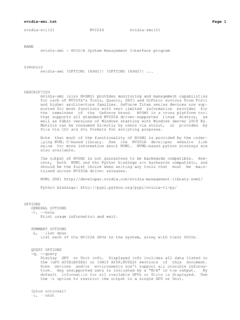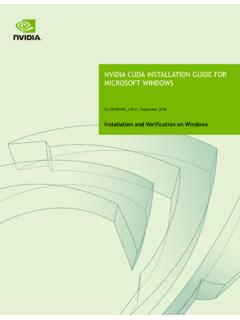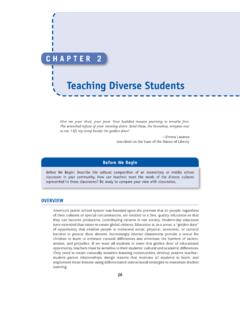Transcription of cascaded shadow maps - Nvidia
1 cascaded shadow Maps Rouslan Dimitrov Nvidia Corporation August 2007 1. cascaded shadow Maps Document Change History Version Date Responsible Reason for Change Rouslan Dimitrov Initial release Miguel Sainz Figures and minor editorial fixes cascaded shadow Maps shadow maps are a very popular technique to obtain realistic shadows in game engines. When trying to use them for large spaces, shadow maps get harder to tune and will be more prone to exhibit surface acne and aliasing. cascaded shadow maps (CSM) is a know approach that helps to fix the aliasing problem by providing higher resolution of the depth texture near the viewer and lower resolution far away. This is done by splitting the camera view frustum and creating a separate depth-map for each partition in an attempt to make the screen error constant. CSM are usually used for shadows cast by the sun over a large terrain. Capturing everything in a single shadow map would require very high and impractical resolution.
2 Thus, several shadow maps are used - a shadow map that covers only nearby objects so that each casts a detailed shadow ; another shadow map that captures everything in the distance with coarse resolution and optionally some more shadow maps in between. This partitioning is reasonable because objects that are far away cast shadows that in screen space occupy just a few pixels and close-by objects might cast shadows that occupy a significant part of the screen. Figure 1-1 shows a schematic of parallel split CSM, where the splits are planes parallel to the near and far planes and each slice is a frustum itself. The sun is a directional light, so the associated light frusta are boxes (shown in red and blue). The algorithm proceeds as follows: For every light's frustum, render the scene depth from the lights point of view. Render the scene from the camera's point of view. Depending on the fragment's z-value, pick an appropriate shadow map to the lookup into.
3 cascaded shadow Maps Figure 1-1. The right-most tree is captured in the near shadow -map and the other two are in the left. As seen from a viewer on the side, the left shadows are blocky, however, the camera would perceive all 3 shadows with approximately the same aliasing. Related Work There are several other popular approaches try to improve the screen-space aliasing error. The ones mentioned here traditionally work on the whole view frustum. Although these techniques can be applied to every frustum slice of CSM, this would not improve significantly the visual quality and comes with the expense of much greater algorithm complexity. In fact, CSM can be thought of a discretization of Perspective shadow Maps. Perspective shadow Maps (PSM) [2] Figure 1-1 shows that part of the light's frustum doesn't contain potential occluders and is outside of the camera view frustum and this part of the shadow map is wasted.
4 The idea behind PSM is to wrap the light frustum to exactly coincide with the view frustum. Roughly, this is achieved by applying standard cascaded shadow Maps shadow mapping in post-perspective space of the current camera. A drawback of this method is that position and type of the light sources changes not intuitively and thus this method is not very common in computer games. Light Space Perspective shadow Maps (LiPSM) [4] wrap the camera frustum in a way that doesn't change the directions of light sources. A new light frustum is built that has a viewing ray perpendicular to the light's direction (parallel to the shadow map). The frustum is sized appropriately to inclue the camera frustum and potential shadow casters. Compared to PSM, LiPSM doesn't have as many special cases, but doesn't use the shadow map texture fully. Trapezoidal shadow Maps (TSM) [5] build a bounding trapezoid (instead of the frustum in LiPSM) of the camera frustum as seen from the light.
5 The algorithm proceeds similarly to the other approaches. Detailed Overview The following discussion is based on the OpenGL SDK demo on cascaded shadow maps and will explain the steps taken in detail. The shadow maps are best stored in texture arrays with each layer holding a separate shadow map. This allows for efficient addressing in the pixel shader and is reasonable since all layers are treated essentially in the same way. shadow -map generation By looking at figure 1-1, it can be noticed that everything outside the current light frustum (box) should not be rendered, provided that all shadow casters and the camera frustum slice are contained within it. In a way, the light's frustum is a bounding box of the camera frustum slice, with near side extended enough to capture all possible occluders. If there were an occluder B (a bird, for example) above the trees, the boxes should be extended appropriately, or B wouldn't cast a shadow .
6 Figure 2-1. Camera frustum splits The first step of the algorithm is to compute the z-values of the splits of the view frustum in camera eye space. Assume a pixel of the shadow map has a side length ds. The shadow it cascaded shadow Maps casts occupies a fraction dp of the screen which depends on the normal and position of the object being shadowed. Referring to diagram 2-1, dp dz cos . =n ds zds cos . where n is the near distance of the view frustum. In theory, to provide exactly the same error on the screen, dp/ds should be constant. In addition, we can treat the cosine dependent factor also as a constant because we minimize only the perspective errors and it is responsible for projection errors. Thus, dz = , = ln( f / n). zds where the value of is enforced by the constraint s [0;1] . Solving the above equation for z and discretizing, (assuming the number of splits N is large), the split points should be exponentially distributed, with: z i = n( f / n ) i / N.
7 Where N is the total number of splits. Please refer to [1] for a more detailed derivation. Figure 2-2. Light frusta from light directly above the viewer However, since typically N is between 1 and 4, the equation makes the split points visible because the shadow resolution changes sharply. Figure 2-2 shows the reason for the discrepancy: the area outside the view frustum, but inside the light frusta is wasted because it is not visible; however as N this area goes to 0. cascaded shadow Maps To counter this effect, a linear term in i is added and the difference is hardly visible anymore: z i = n( f / n) i / N + (1 )(n + (i / N )( f n) ). where controls the strength of the correction. After the splits in z are known, the corner points of the current frustum slice are computed from the field of view and aspect ratio of the screen. Refer to [3] for details. Figure 2-3. Effect of the crop matrix and z-bounds change Meanwhile, the modelview matrix M of the light is set to look into the light's direction and a generic orthogonal projection matrix P=I is set.
8 Then, each corner point p of the camera's frustum slice is projected into ph = PMp in the light's homogeneous space. The minimum mi and maximum Mi values in each direction form a bounding box, aligned with the light frustum (box), from which we determine a scaling and offset to make the generic light frustum exactly coincide with it. This in effect makes sure that we get the best precision in z and loose as little as possible in x and y and is achieved by building a crop matrix C. Finally, the projection matrix P of the light is modified to P=CPz, with Pz an orthogonal matrix with near and far planes at mz and Mz and 2. Sx =. Sx 0 0 Ox M x mx . 0 Sy 0 Oy 2. C = , Sy =. 0 0 1 0 M y my O x = ( M x + m x ) S x 0 0 0 1 .. O y = ( M y + m y ) S y Note that we can make the light's frustum exactly coincide with the frustum slice, but this changes the light's direction and type as in perspective shadow maps cascaded shadow Maps The scene is also frustum culled for each frustum slice i and everything is rendered into a depth layer using (CPfM)i as modelview and projection matrices and the whole procedure is repeated for every frustum partition.
9 Final scene rendering In the previous step, the shadow maps 1 N were generated and are now used to determine if an object is in shadow . For every pixel rendered, its z-value should be compared to the N. z-ranges computed before. For the following, assume it falls into the i-th range. Note that the pixel shader receives this value in post-projection space, while it was originally computed in eye space. Then, the fragment's position is transformed into world space, using the camera inverse modelview matrix Mc-1 (which need not be a full inverse the top 3x3 portion could be transposed only if scaling is not used). Afterwards, it is multiplied by the matrices of the light for slice i. The transformation is captured in the following composite matrix (CPfM)i Mc-1 . Finally, the projected point is linearly scaled from [-1; 1] to [0; 1]. After all this transforms, the fragment's (x,y) position is actually a texture coordinate of the i-th depth map and the z- coordinate tells the distance from the light to the particle.
10 By doing the lookup we see the distance from the light to the nearest occluder in the same direction. Comparing these two values tells whether the fragment is in shadow . cascaded shadow Maps Figure 2-4. A triangle casting a shadow in multiple depth maps Code Overview The accompanying OpenGL SDK sample contains the following source files: contains function definitions for loading and rendering the environment. The only method needed for the shadow mapping algorithm is Draw(), while Load() and GetDim() are called during initialization to load and set the bounding box of the world properly. contains many helper functions in order to make the main code more readable. These include a shader loader; camera handling; menu, keyboard and mouse handling, etc. this file contains the main core code of the presented algorithm and contains all code for creating and drawing the shadow maps and the final image to the screen.
